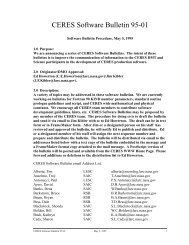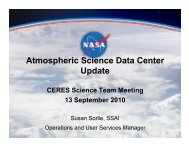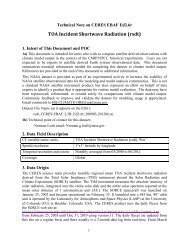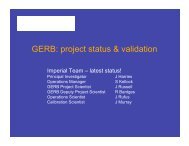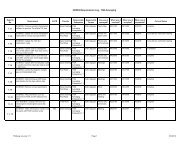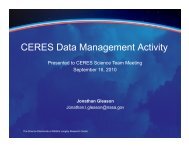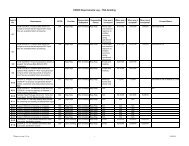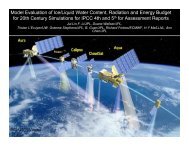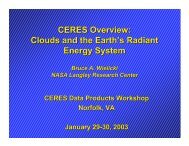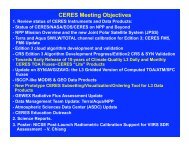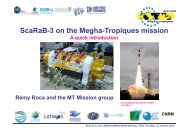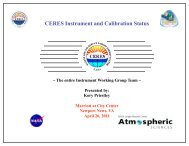State of CERES/NASA/EOS/Senior Reviews
State of CERES/NASA/EOS/Senior Reviews
State of CERES/NASA/EOS/Senior Reviews
- No tags were found...
You also want an ePaper? Increase the reach of your titles
YUMPU automatically turns print PDFs into web optimized ePapers that Google loves.
Norman G. Loeb, <strong>NASA</strong> LaRC<strong>CERES</strong> Science Team Meeting September 13, 2010, Paris, France
<strong>NASA</strong> Earth Science• <strong>NASA</strong> Administrator is Charles Bolden, Jr.• AA for Space and Earth Science is Ed Weiler.• Head <strong>of</strong> Earth Science is Mike Freilich.• Jack Kaye is Associate Director for R&A.• David Considine is <strong>NASA</strong> HQ Modeling lead and <strong>CERES</strong>Program Scientist.• Hal Maring remains Radiation Sciences program lead.• Steve Volz is the Earth Science Deputy for Missions.• Richard Slonaker is Program Executive, <strong>NASA</strong>-HQ.
<strong>NASA</strong> Science Mission Directorate FY11 President’s Budget Request- Increases across the board from FY10 to FY15. Earth Science increases by 60%.- FY11 ES increases by $382 million over FY 2010 enacted, and $1.8 billion over 4-years (FY 2011-14) compared to the FY 2010 Budget;- Re-flies the Orbiting Carbon Observatory, which is critical to our understanding<strong>of</strong> the Earth’s carbon cycle and its effect on climate change;- Accelerates the development <strong>of</strong> new satellites to enhance observations <strong>of</strong> theclimate and other Earth systems;- Expands and accelerates Venture-class competitive PI-led missions;- Enhances climate change modeling capabilities to enhance forecasts <strong>of</strong> regionaland other effects;- Operates 15 Earth-observing spacecraft in orbit and launches Glory, NPP, andAquarius;- Proceeds toward completion and launch <strong>of</strong> remaining foundational missions:LDCM (6/13) and GPM (7/13).
PFMFM1FM2FM3FM4
<strong>CERES</strong> Team Leads• Principal Investigator: Norman Loeb• Project Scientist: Kory Priestley• <strong>CERES</strong> Working Groups:• Instrument: Kory Priestley• ERBElike: Takmeng Wong• Clouds: Pat Minnis• Inversion: Norman Loeb• SOFA: David Kratz• SARB: Tom Charlock• TISA: David Doelling• FLASHFlux: Paul Stackhouse & David Kratz• Data Management: Jonathan Gleason• ASDC: John Kusterer
<strong>CERES</strong> News• “The Science <strong>of</strong> Terra and Aqua” <strong>NASA</strong> ROSES proposals(March 2010).• AMS Radiation Conference (Joint with Cloud Physics):- June 28–July 2, 2010. Portland OR.-> ≈ 40 papers that use <strong>CERES</strong> (21% <strong>of</strong> AtRad Conf).• Workshop on next generation Earth radiation budgetobserving requirements – NOAA NCDC in Asheville, NC13-14 July.• IGARSS Terra at 10 session. July 26-30. Honolulu, HI
<strong>CERES</strong> News<strong>CERES</strong> Ocean Validation Experiment(COVE) Site:- Operates instruments from BSRN,AERONET, MPL.- US Coast Guard wants to excess orauction <strong>of</strong>f the Chesapeake Lighthouseplatform.- <strong>State</strong> and local (VA Beach) governmentsconsidering. VA Beach sentCoast Guard a letter <strong>of</strong> intent to takeplatform over. Not sure what theywill use it for.- If VA Beach changes it’s mind, lighthousewill be auctioned <strong>of</strong>f.- Our goal is to continue observations regardless <strong>of</strong> whoassumes responsibility for lighthouse.
Upcoming Conferences & Meetings <strong>of</strong> Interest<strong>CERES</strong> Science Team Meeting:- Fall 2010: Sept 13-16. Paris, France. <strong>CERES</strong>/ScaRaB/GERB/LMDEUMETSAT Meteorological Satellite Conference:- September 20-24, 2010. Cordoba, Spain.SPIE Asia-Pacific Remote Sensing:- October 11-14, 2010. Incheon, Republic <strong>of</strong> Korea.PCMDI-<strong>NASA</strong> Meeting:- <strong>CERES</strong> invited to contribute to CMIP5 and IPCC AR5 – Data Portalfor Earth System Grid. Oct 12 meeting at Lawrence LivermoreNational Laboratory (LLNL).A-Train Symposium:- October 25-28, 2010. New Orleans, LAFall AGU:- December 13-17, 2010. San Francisco, CAObserving and Modelling Earth's Energy Flows:- 10-14 Jan 2011, ISSI, Bern, Switzerland (by Invitation)AMS Annual Meeting- 23-27 Jan 2011, Seattle, WA
<strong>CERES</strong> Webpage Redesign http://ceres.larc.nasa.gov/
New <strong>CERES</strong> L3 Data Subsetting/Visualization/Ordering Tool(http://ceres.larc.nasa.gov/order_data.php)• Menu-driven, parameterbased subsetting.• Visualize data beforeordering (regional,zonal and global plots,google-Earth enabled,create movies, etc.).• Download data directlyfrom site.• Output in netCDF andASCII.• Improved documentation.
<strong>CERES</strong> Terra/Aqua Edition3 Improvements- <strong>CERES</strong> Instrument group have completed Edition3 gains andtime-varying spectral response function changes for 10 years <strong>of</strong>Terra and 7 years <strong>of</strong> Aqua measurements !!!!!!- This work has been 5 years in the making. Countlessbrainstorming sessions, strategy meetings, starts-and-stops,etc.- Credit goes to: Kory Priestley, Susan Thomas, NitchieManalo-Smith, Dale Walikainen, Mohan Shankar, PeterSzewczyk, Phil Hess, Denise Cooper, Robert Wilson andGrant Matthews.
Discovery <strong>of</strong> spectral darkening problem in November 2004.
Introduction <strong>of</strong> user-applied rev1 corrections in May 2005.
Edition3 Instrument Improvements (September 2010).
A Decade <strong>of</strong> Global <strong>CERES</strong> Top-<strong>of</strong>-AtmosphereRadiation Anomalies (<strong>CERES</strong> SSF1deg-lite_Ed2.5)<strong>CERES</strong> is providing the first decadal global climate data record <strong>of</strong> the Earth’sRadiation Budget at climate accuracy from broadband instruments.
32-years <strong>of</strong> Radiation Measurements(LW Anomaly; 20°S-20°N)
<strong>CERES</strong> Terra/Aqua Edition2.5 Lite Data ProductsMotivation: To get instrument calibration improvements into<strong>CERES</strong> level-3 (gridded monthly) data products ASAP.- Delivery and processing <strong>of</strong> full-suite <strong>of</strong> level-2 and 3algorithm improvements will much more time.- How can new calibration improvements make their wayinto L3 data products now?The <strong>CERES</strong> Edition2.5 “Lite” products:-> Uses best-quality Edition3 instrument radiances andexisting Ed2 cloud properties to generate L3 TOA fluxesas quickly as possible.-> Will consist <strong>of</strong> a small subset <strong>of</strong> SRBAVG cloud and TOAradiation parameters.-> Accompanied by a new prototype subsetter/visualization/ordering tool.-> Currently ready to release gridded daily and monthlySSF1deg-lite_Ed2.5, SYN1deg-lite_Ed2.5 and EBAF Ed2.5.
Parameter List in <strong>CERES</strong> “Lite” Data ProductsSYN1deg-lite_Ed2.5-> Similar to SRBAVG G<strong>EOS</strong>SF1deg-lite_Ed2.5=> Similar to SRBAVGnonGEO- Daytime-only and day/night average cloudproperties.- Time-varying TOA solarirradiance from SORCE.
Does Diurnal Cycle <strong>of</strong> Radiation Matter?Annual Cycle <strong>of</strong> Albedo for Marine Stratus and LandConvection from 8 Years <strong>of</strong> <strong>CERES</strong> TerraMarine Stratus AlbedoJ F M A M J J A S O N DConvective Cloud AlbedoJ F M A M J J A S O N D• Diurnal variations in marine stratus and convective clouds have a stronginfluence on the amplitude <strong>of</strong> the annual cycle <strong>of</strong> albedo for these cloud types.• Merging <strong>CERES</strong> Terra with geostationary satellite observations captureschanges in both diurnal and annual cycles <strong>of</strong> albedo.
<strong>CERES</strong> Terra/Aqua Edition2.5 Lite Data Products
10-year Regional Trends (Wm -2 per decade)SYN1deg-lite_Ed2.5(GEO)SFF1deg-lite_Ed2.5(non-GEO)SYN1deg minus SSF1deg
Energy Balanced and Filled (EBAF) Ed2.5A• All-sky TOA Fluxes: Adjust SW and LW TOA fluxes in SYN1deglite_Ed2.5within their range <strong>of</strong> uncertainty to remove theinconsistency between average global net TOA flux and estimatedheat storage in the Earth-atmosphere system.• Clear-sky TOA Fluxes: Uses <strong>CERES</strong>+MODIS clear-sky fluxes to “fillin gaps” in standard <strong>CERES</strong> clear-sky TOA flux products.
High-Resolution vs Coarse-Resolution Clear-Sky LW TOA Flux<strong>CERES</strong>/MODIS minus<strong>CERES</strong> clearskyLW TOAflux (Wm -2 )PrecipitableWater (mm)
Re-Prioritization <strong>of</strong> <strong>CERES</strong> Edition3 Data Products- Currently running Edition2 for all subsystems. Ed2.5 Lite dataproducts only include small subset <strong>of</strong> <strong>CERES</strong> parameters.- Instrument running both Editions 2 and 3 BDS/IES products.- Getting the full-suite <strong>of</strong> Level 1 through 3 planned Edition3algorithm improvements has been slow:- Discovery <strong>of</strong> spectral darkening <strong>of</strong> SW channel (Instrument).- Clouds waiting for CALIPSO/Cloudsat validation.- MTSAT problem (TISA).- Production code migration effort from SGI -> IBM Linux clusterenvironment.- SAN failure in August 2008: loss <strong>of</strong> 6-8 months for some workinggroups.- Feb 2010: Unplanned power outage and subsequent LUN thrashingissue.- New scripting requirement for deliveries to AMI, our new productionenvironment.- Re-architecting <strong>of</strong> AMI in August 2010.- Production on AMI has not started yet: ~1.5 years behind schedule.
Alternate Edition3 Strategy- Produce a scaled-down version <strong>of</strong> Edition3 that includes only asubset <strong>of</strong> the algorithm improvements proposed in the 2009 <strong>Senior</strong>Review that can be processed now on the older SGI (Warlock), P4(Magneto) and available P6, X86 (AMI-P) systems.- Edition3 Algorithm improvements: Instrument calibration andspectral characterization. SOFA surface fluxes. Updated polar andANN ADMs, merged Terra+Aqua+GEO.- Utilize existing inputs that are “ready-to-go” now (MOA, MODIS,GGEO, MATCH, etc.).- Process only crosstrack instrument for Level-2 and -3 dataproducts.- All other algorithm/input file improvements (e.g., Clouds, ADMs,SARB, TISA) included in Edition4 and run on AMI or AMI-P.
Pros and Cons <strong>of</strong> New Edition3 StrategyPros:- Provides full-suite <strong>of</strong> <strong>CERES</strong> data products with instrument calibrationimprovements in shortest time.- Will supersede “lite” data products planned for subsetter.- Gets merged Terra+Aqua SYN1deg out sooner.- Edition4 will have consistent Clouds and ADMs.- Provides more time for Clouds Edition4 delivery (July 25 to October15, 2010).- Risk mitigation: new cloud algorithm on new platform.- Provides more time for TISA Edition4 delivery (date TBD).- Baby-step to Edition4 likely increase chance <strong>of</strong> Edition4 gettingthrough more smoothly.Cons:- Delays processing Edition3 ERBE-like until after <strong>Senior</strong> Review.- Delays release <strong>of</strong> cloud algorithm improvements as “Edition”version.- Some data products will not be produced as Edition3 due to limitedcomputational resources (e.g., CRS, FSW).- New parameters added to <strong>CERES</strong> data products (e.g., SSF) delayed.
Terra and Aqua <strong>Senior</strong> Review - 2011- Likely due March 2011.- Will need science team input on submitted, in-press andpublished journal articles.- Will summarize accomplishments during past 2 years andgoals for next 4 years.- Determines <strong>CERES</strong> budget for next 2 years.Objectives for 2011 <strong>Senior</strong> Reviewi) 10-years <strong>of</strong> Terra <strong>CERES</strong>_SSF1deg_Ed3 monthly,dailyii) 8-years <strong>of</strong> Aqua <strong>CERES</strong>_SSF1deg_Ed3 monthly,dailyiii) 5-years <strong>of</strong> Edition3 merged Terra+Aqua SYN1deg_Ed3iv) Final delivery <strong>of</strong> Edition4 Clouds with all algorithmimprovements previously due for delivery July 25, 2010(new deadline: October 15).
<strong>CERES</strong> FM5 on NPP Update.• Comprised <strong>of</strong> 5 instruments:- Visible/Infrared Imager/Radiometer Suite (VIIRS)- Cross-track Infrared Sounder (CrIS)- Clouds and the Earth’s Radiant Energy System (<strong>CERES</strong>)- Ozone Mapping Pr<strong>of</strong>iler Suite (OMPS)- Advanced Technology Microwave Sounder (ATMS)• Status:- <strong>CERES</strong>, ATMS, OMPS, VIIRS on NPP spacecraft. CrIS wasshipped June 17 and integrated on spacecraft in July.• Official launch date: October 2011• Significant concern over readiness <strong>of</strong> ground system.
<strong>CERES</strong> FM6 on NPOESS C1• <strong>CERES</strong> FM6 is a government-furnished sensor manufacturedby Northrop Grumman (NG), and provided to the JPSS programby NOAA/<strong>NASA</strong>.• Northrop Grumman Aerospace System (NGAS) working undercontract to <strong>NASA</strong> LaRC.• Build-to-Print and from spare parts.• Minor modifications needed to accommodate JPSS spacecraftinterface and improve calibration.• Start Date: May 2009; Delivery Date: July 2012; Launch in 2014.• Successfully complete delta Preliminary Design Review inJanuary 20, 2010.• Received NOAA’s FM6 Level-1 Requirements July 1.• <strong>NASA</strong> preparing response to NOAA L1 Requirements.• Delta Critical Design Review to be held September 28, 2010.
A-Train Update• PARASOL started drifting away from A-Train in early Jan 2009due to insufficient fuel needed to maintain A-Train orbit.• Glory launch expected November 22, 2010.• Japanese GCOM-W may join A-Train in 2012 with successor toAMSR-E instrument.• CALIPSO passed 1000 day-mark in orbit on January 23, 2009.Successfully transitioned to backup laser on March 9, 2009. Hasreleased Version 3 data products from ASDC.• New merged CALIPSO-CloudSat-<strong>CERES</strong>-MODIS (C3M) dataset:1 year (Jul06-Jun07) has been processed. Plan to processseasonal months in 2008 next (see S. Kato Co-I presentation).• A-Train Symposium: October 25-28, 2010. New Orleans, LA
Decadal Survey• <strong>NASA</strong> still committed to implementing DS. Tier 1 Missions:- Climate Absolute Radiance and Refractivity Observatory(CLARREO)- Deformation, Ecosystem Structure and Dynamics <strong>of</strong> Ice(DESDynI)- Soil Moisture Active-Passive (SMAP)- Ice, Cloud, and Land Elevation Satellite (ICESat-II)
End



